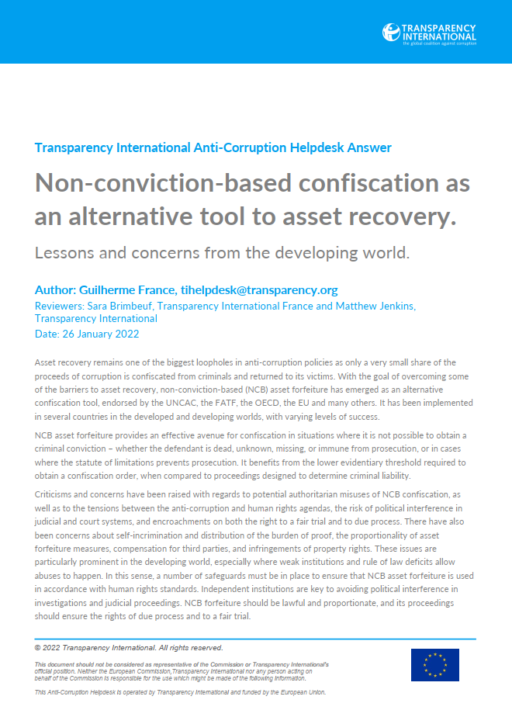- Home
- Anti-Corruption Helpdesk
- Non-conviction-based confiscation as an alternative tool to asset recovery: Lessons and concerns from the developing world.
Non-conviction-based confiscation as an alternative tool to asset recovery: Lessons and concerns from the developing world.

This Anti-Corruption Helpdesk brief was produced in response to a query from one of Transparency International’s national chapters. The Anti-Corruption Helpdesk is operated by Transparency International and funded by the European Union.
Query
What is non-conviction-based asset forfeiture and why has it emerged as alternative confiscation tool to strengthen asset recovery efforts? What are the main concerns with its implementation, especially in developing countries? Please provide examples from Africa and Latin America.
Summary
Asset recovery remains one of the biggest loopholes in anti-corruption policies as only a very small share of the proceeds of corruption is confiscated from criminals and returned to its victims. With the goal of overcoming some of the barriers to asset recovery, non-conviction-based (NCB) asset forfeiture has emerged as an alternative confiscation tool, endorsed by the UNCAC, the FATF, the OECD, the EU and many others. It has been implemented in several countries in the developed and developing worlds, with varying levels of success.
NCB asset forfeiture provides an effective avenue for confiscation in situations where it is not possible to obtain a criminal conviction – whether the defendant is dead, unknown, missing, or immune from prosecution, or in cases where the statute of limitations prevents prosecution. It benefits from the lower evidentiary threshold required to obtain a confiscation order, when compared to proceedings designed to determine criminal liability.
Criticisms and concerns have been raised with regards to potential authoritarian misuses of NCB confiscation, as well as to the tensions between the anti-corruption and human rights agendas, the risk of political interference in judicial and court systems, and encroachments on both the right to a fair trial and to due process. There have also been concerns about self-incrimination and distribution of the burden of proof, the proportionality of asset forfeiture measures, compensation for third parties, and infringements of property rights. These issues are particularly prominent in the developing world, especially where weak institutions and rule of law deficits allow abuses to happen. In this sense, a number of safeguards must be in place to ensure that NCB asset forfeiture is used in accordance with human rights standards. Independent institutions are key to avoiding political interference in investigations and judicial proceedings. NCB forfeiture should be lawful and proportionate, and its proceedings should ensure the rights of due process and to a fair trial.
Contents
- Introduction
- Asset Recovery
- Confiscation
- Different confiscation methods
- Non-conviction based (NCB) forfeiture
- International legal basis
- Rationale for NCB forfeiture
- Common features of NCB forfeiture
- International initiatives supporting implementation of NCB forfeiture
- Human Rights concerns
- Lessons from the developing world
- References
Main points
- Non-conviction-based confiscation has emerged as an alternative tool to help overcome barriers to asset recovery.
- It is particularly useful when it is not possible to obtain a criminal conviction due to the criminals being dead, missing, unknown, immune from prosecution or due to the statute of limitations having run out.
- NCB forfeiture proceedings usually require a lower evidentiary threshold to demonstrate that particular assets have an illicit origin or destination.
- There are concerns about the impact of NCB forfeiture on property rights, as well as on the presumption of innocence and the rights to a fair trial and due process.
- If the necessary rule of law and human rights safeguards are in place, NCB forfeiture can become an important anticorruption tool.
Authors
Guilherme France, [email protected]
Reviewers:
Sara Brimbeuf, Transparency International France and Matthew Jenkins, Transparency International
Date
03/02/2022
Tags
 Download PDF
Download PDF
